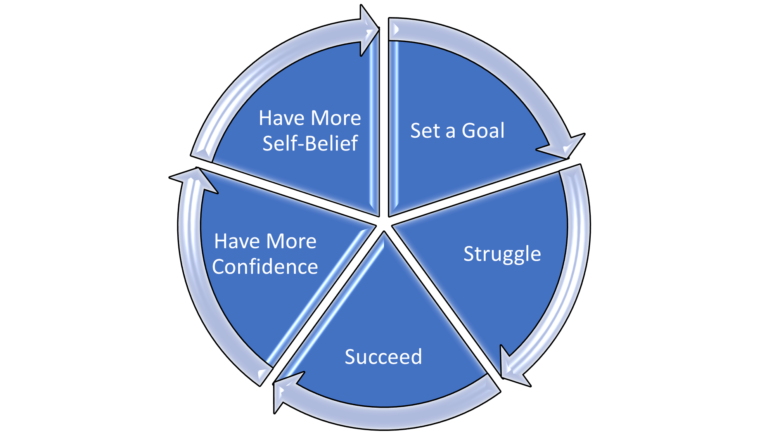
Waking in the morning, we think about life and dream about where we want to be and what we want to do.
With a rush of inspiration, we create a goal!
Setting goals is easy.
“I will exercise more, eat healthily, and save money.”
Lofty intentions…. inspiring us to jump out of bed to conquer the day.
Reality sets in, and we roll over and hide.
Achieving goals is hard.
Over the years of being in the advice industry, I have seen many exciting dreams succumb to the bottom drawer when life overshadowed those inspiring intentions.
So how do we make achieving goals easier?
A goal needs a Why, a Will, and a Way.
Achieving goals requires behaviour change, which only occurs with the right mindset and a supportive environment.
We know from behavioural science, that our actions shape our reality and success comes from what we do, not what we say we will do
Then we ponder what’s involved.
Things to do!
Changes to make!
Get out of bed earlier, stop eating chocolate, and stop buying takeaways.
Setting Goals is Easy, Achieving them is Hard!
What will we cover?
- Discover the truth behind goals,
- Learn why goals are an important part of our existence,
- Know what goes into a goal, the Why, the Will, and the Way,
- Use our FREE worksheet to develop a goal for something important to you now.
What is a Goal?
Something you want, that you couldn’t get without extra work or action.
For most of us, driving our car to the supermarket is not a goal. We make the trip easily, without extra work or help.
But, for a teenager, driving becomes a goal. To succeed, they must study, practice, and learn new actions and habits, before they can drive a car.
“Goals are usually things we want but have difficulty achieving even when we know they are achievable.”
(Elliot T Berkman)
To obtain that goal, we must change our behaviour. That is why setting a goal is easy, but achieving the goal is hard. Life is much easier when we keep doing what we have always done, to get the results we have always had. This is not because we are lazy, there is a lot more going on here than we realise.
The reason we revert to our ‘normal’, is that we much prefer the Status Quo.
We get very concerned about making the wrong decision. We don’t like to experience loss or regret, so instead of jumping into the unknown, we stick to our current ways. A bit of ‘the devil you know versus the devil you don’t.
Why should we set goals?
Because we love the feeling of accomplishment, and that feeling is good for us.
People, have a fundamental need for growth, and when we fulfill this need, our brains get a natural high and we want more.
The struggle is what creates personal growth and development.
Consider the goal circle below.

Through the circle of setting a goal, struggling, and succeeding, we are building greater self-confidence and belief.
We develop an internal locus of control over our lives and a positive outlook overall.
As with any muscle, the more we practice, the stronger and easier life becomes.
Often, however, we focus so much on the endpoint of the goal, we forget the habits we form on the way.
So, how do we make the behaviour changes needed to hit the target?
Accomplishing a goal, requires a Why, Will and a Way.
The Why and the Will
The motivation behind a goal
Our Why and our Will are somewhat connected, so we will combine those two forces now.
Everything we do in life moves us toward one of our five human needs.
- Security – the need to feel safe, and on an even footing,
- Variety – once we are safe we get bored, so look for fun, something different,
- Meaning or significance – we want to feel we have a purpose in life, that we matter,
- Connection – we have an innate need to connect with other people, ideas, and the environment around us,
- Contribution – a feeling of giving back, and helping others is a core human need,
- Growth – everything in life wants and needs to grow. Once we stop growing, life loses meaning. Goals give us this meaning.
Our goals must reflect these core needs, or we won’t be motivated to achieve them.

Look at the two examples below.
Which goal is more compelling and more likely to be accomplished?
Goal A
We want to save money to go on an overseas trip.
Goal B
We will save $5,000 to go to Australia in one year, to spend time with my sister, whom I miss dearly, and to create lasting memories as a family before Sam goes off to university.
By doing this we get a break, a chance to recharge and relax on the beach, enjoying great food and fun with the people we love and miss.
If we don’t do this, we will regret not seeing our family in Oz, Sam will leave for university, and we will have missed that special time with him.
In the first goal we state an intention with no real reason for doing it.
In the second goal, we state exactly why we will take our trip, what it means to us, and what happens if we don’t go.
What Drives us in Life?
Did you notice, at the end of the goal above, we said two things, one was what we would get from achieving the goal and one was what we would lose if we didn’t?
There are two driving forces behind our actions in life.
- To move towards pleasure or
- To move away from pain.
We want to use these natural instincts, to motivate us to action.
In the example above, we visualised the pleasure we would see, hear, or feel when we took the trip. Then we used pain, to reiterate, what we would lose if we didn’t take the trip.
How do you know if a goal is strong enough?
Is the pain of not achieving that ambition, stronger than the pleasure of giving up? When the going gets tough, will the regret of walking away, hurt more than the pain of making the harder decision?
The Way
The ‘Way’ is our ability to take the actions we need to succeed. We can have a goal to fly a plane, but unless we know how to take off, we are not getting into the sky.
It is the same with money. We need to know how we will save the $5000 and then take the steps required to get there.
This is where we take goals for granted.
Too often, all of the emphasis is placed on the final outcome. The house, the car, the trip. The truth is, that real success comes from the journey you take on the way.
That is where you grow as a person and move to a new place in your life.
Never underestimate the work it takes to save even a small amount of money.
So be proud of what you learn, as you strive for a better life.

Where are we Now?
So far, we have learned goals.
- Require behaviour change,
- Need to relate to our core human needs,
- Either move us towards pleasure or away from pain,
- Goals are not about the destination, they are about the journey and growth,
- To take that journey, we need to know what to do and how and this is where we will acquire new skills and develop as people.
So, why can we have all of this in place and still fail?
Get the environment right.
What do you feel like for lunch?

The decision is easy when you create an environment that supports your goal, not one that stands in the way.
When it comes to savings, try the following ideas for that right environment.
- Tell a friend about your goal.
- Set up a separate bank account for the savings.
- Transfer savings into the account automatically, at payday.
- Write up a commitment statement.
- Email the statement to yourself each month, as a reminder to check your progress and adjust as you need too.
Time to Wrap Up
We have covered a lot today and there is more to come.
Before we leave you, remember, we move towards what is most important to us, or what is pleasurable, and we move away from pain.
To achieve a goal, we need to align it to our core needs and give ourselves a compelling why. Otherwise, when that conflict comes along, we will always take the path of least resistance and that is to usually do nothing, rather than jump into the unknown.
It is normal to fear change, which is why our goals are easy to set and hard to achieve.
Don’t underestimate what it takes to succeed. We need a driving Why and Will and the Way to get there.
As Tony Robbins says, “Breakthrough depends on your state, the story you tell yourself, and your strategies.”
Strategies come last and we cover that in our blog How to Save Without Budgets.
We must first develop a great state of mind and an undeniable story behind why we want to get there.
Then we need to give our goal a nudge along, with a supportive environment.
I leave you with this final question.
What does your ‘money fridge’ look like? Is it full of easy ways to save? Let’s make it easy to choose the salad!

Set A Goal With Us Now
There is no time like the present to take action.
Fill in your details below and we will help you set a goal, step by step.
Article by Kim Gabites (Inside My Money Founder)

www.insidemymoney.co.nz
is an online financial learning hub, helping first home buyers gain more financial know-how and confidence.
References
The Neuroscience of Goals and Behavior Change Elliot T. Berkman
Samuleson and Zeckhauser (1988)
Maslow’s Hierarchy of Needs, Tony Robbins, Core Human Needs
What is Goal Setting and How to Do it Well 9 Apr 2019 by Elaine Houston, B.Sc. Scientifically reviewed by Tiffany Sauber Millacci, Ph.D.




